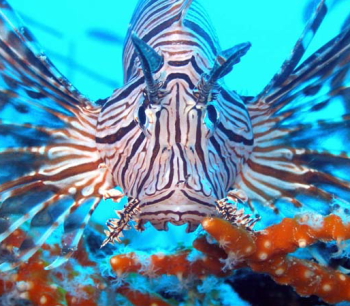In a perfect world, every fish, invertebrate, or alga introduced to a marine aquarium would be allowed to live out its entire lifespan there. But as we all know, there are many contingencies that can make it necessary for hobbyists to part with livestock—serious compatibility issues arising, an animal purchased on impulse growing too large for its tank, work/family demands changing, etc.
When faced with this prospect, some hobbyists who live in close proximity to tropical seas might think the most humane way to divest themselves of their marine livestock is to release it into the wild—its “natural home.” However, if this thought is currently crossing your mind, we urge you to reconsider. We marine aquarium hobbyists must never, under any circumstances release our animals or algae into the wild—not even into their native waters. Here are several good reasons:
They can prove to be invasive
Pterois spp. lionfish in the Western Atlantic and Caribbean, and Caulerpa macroalgae in the Mediterranean are just a few of many examples of marine species that have become invasive after being introduced to non-native waters in one way or another. Non-native species may outcompete native species for resources and often have no natural predators to keep their populations in check. Thus, they can significantly and adversely impact their adopted ecosystem.
In fact, recent reports have put the spotlight on another invader that’s been discovered on Venezuelan reefs. Xenia, an Indo-Pacific coral widely regarded for its explosive weed-like growth, was illegally introduced for commercial propagation purposes. Surprise! Years later it’s spreading uncontrollably and choking out native coral species. Facepalm, anyone?
Even the mere act of disposing of aquarium salt water in such a manner that it can reach natural waterways can cause major problems—for example, if it contains harmful parasites or microorganisms or the spores of non-native algae.
They can introduce disease
Captive marine livestock may be exposed to parasites or pathogens to which their wild counterparts have no natural resistance. The seemingly harmless and humane act of releasing an unwanted specimen could potentially lead to a devastating disease outbreak among wild populations.
It can be cruel
In most cases, fish or other marine organisms released into the wild are subjected to considerable stress and have to run a gantlet of dangers—for which their captive life did not prepare them—in their effort to find a niche and survive in an unfamiliar environment.
It’s illegal
If concerns of invasiveness, disease introduction, or outright cruelty don’t dissuade you from releasing livestock, the threat of a major fine or even imprisonment might. Most (if not all) states have laws against the release of non-native species into local waterways, and the consequences of violating them can be significant.
It gives the hobby a black eye
Whenever problems arise from the wild release of marine livestock, many constituencies out there are quick to point the finger of blame at the marine aquarium hobby—whether there’s any proof that a hobbyist actually released the animal or not. Of course, in many such cases, legislation to prohibit the keeping of said livestock is quick to follow. To ensure that our rights as hobbyists aren’t infringed upon, we must govern ourselves responsibly lest others step in and do the governing for us!




Releasing marine fish back into the wild would certainly be a silly thing to do, but i am sure people do it. But i doubt it would be that harmful compared to how industry pollutes our oceans.